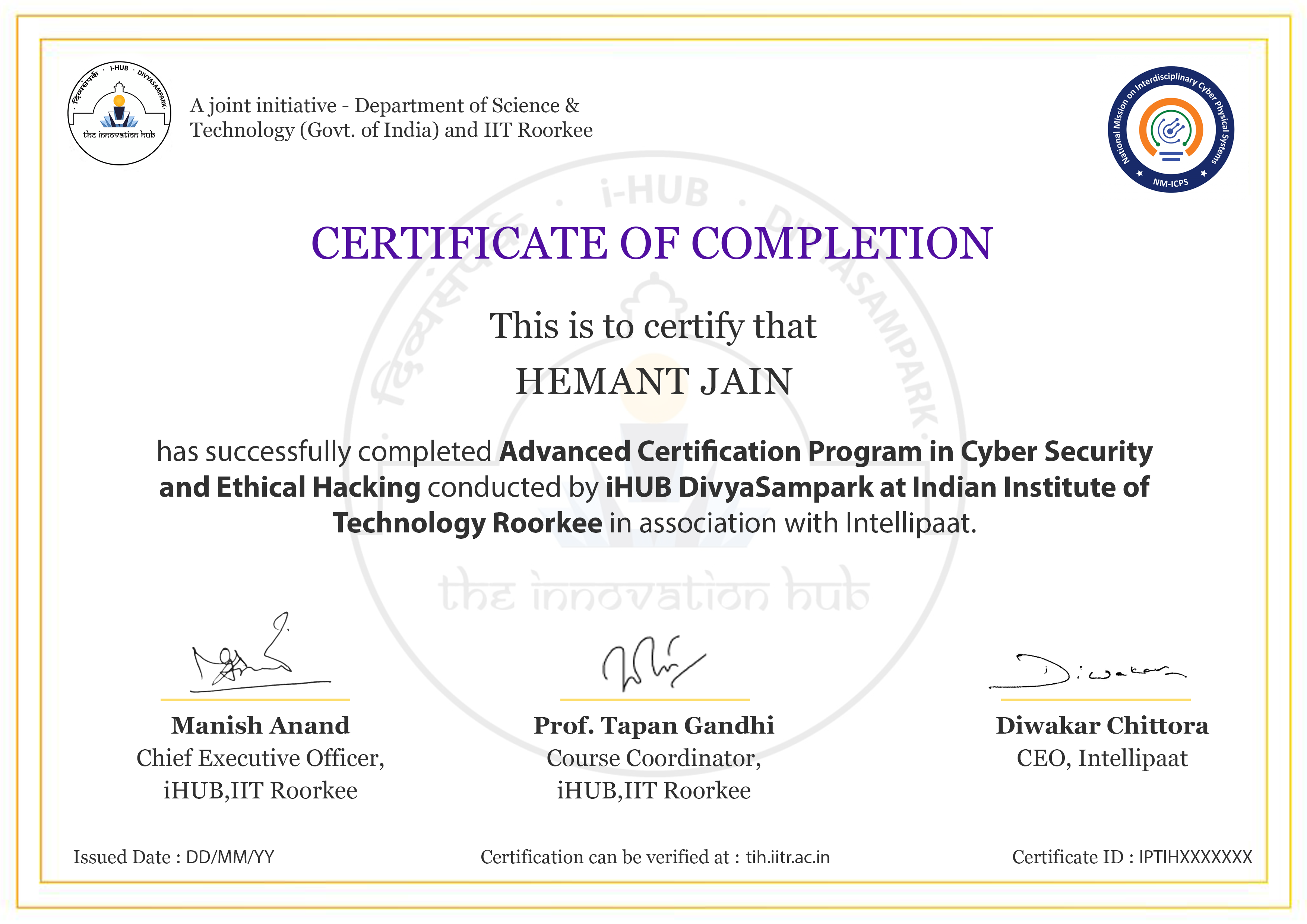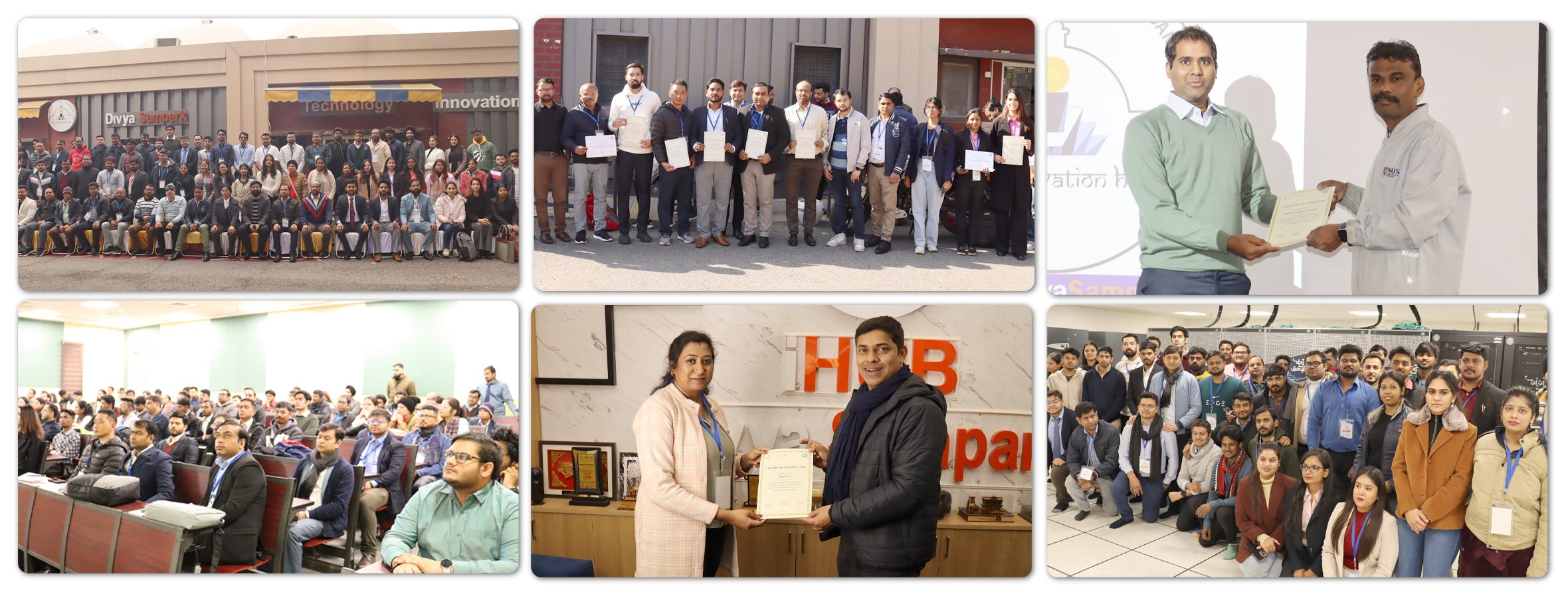Your cart is currently empty.







Watch
Course PreviewThis Cyber Security course, created by iHub IIT Roorkee and EC-Council, trains you to be a certified cybersecurity expert. Learn network security, cryptography, risk analysis, SQL injection, and identity management. Prepare for global certifications and real-world challenges with expert guidance.
This program includes 6 industry-aligned courses, 25+ real-world assessments, and is led by EC-Council Certified Trainers. Earn prestigious certifications like CEH (Certified Ethical Hacker) and IIT Roorkee Certification.
Online Instructor-led Interactive Sessions:
Course 1: Linux Foundations
Course 2: IP Addressing and Security
Course 3: Kali Linux
Course 4: Ethical Hacking: Inline with EC-Council Certified
Course 5: Deep Dive into Cyber Security & Information Security
Course 6: Information System Security Professional (CISSP)
Capstone Project: Secure Web Application
Elective Options: Python Programming Concepts to strengthen your technical skills.
Additionally, this program will provide Multiple Cyber Security Projects and Assignments to strengthen your expertise in Cyber Security and Ethical Hacking.
This Cyber Security program is designed to transform you from a beginner to an industry-ready professional. This training will cover the following things:
In this Cyber Security program, you will learn the following concepts and more:
This Cyber Security online course covers various tools and skills, including:
Cyber Security is a rapidly growing field with a wide range of career paths and specializations.
Here are some of the different career paths you can pursue after this Cyber security training program:
| Career Path | Roles | Number of Openings (India) | Average Salary (India) |
| Cyber Security Analyst | Analyzes security logs and data to identify threats, investigates security incidents, and implements security controls | 30,000+ | ₹6,50,000 per year (Indeed) |
| Security Engineer | As a security engineer, you will be designing, implementing, and maintaining security systems and solutions | 50,000+ | ₹8,00,000 – ₹12,00,000 per year (AmbitionBox) |
| Security Architect | Creates and manages the implementation of security architectures | 20,000+ | ₹12,00,000 – ₹18,00,000 per year (Glassdoor) |
| Security Manager | As a security manager, you will be leading and managing cybersecurity teams | 15,000+ | ₹14,00,000 – ₹20,00,000 per year (AmbitionBox) |
| Chief Information Security Officer (CISO) | Supervises the organization’s overall cybersecurity strategy and program | 5,000+ | ₹17, 70, 000 – ₹94,00,000 per year (AmbitionBox) |
Talk To Us
We are happy to help you 24/7
60% Average Salary Hike
$1,45,000 Highest Salary
6000+ Career Transitions
500+ Hiring Partners
Career Transition Handbook
*Past record is no guarantee of future job prospects
Detects and mitigates security issues, protecting the security of systems and networks against cyber threats.
Design and deploy secure systems and networks in accordance with established security policies and organizational requirements.
Examines existing security systems to detect flaws and suggests ways to improve security.
Develops and implements advanced security measures, such as firewalls and encryption, to protect systems from attackers.
Authorizes simulated cyberattacks to test and identify weaknesses in security defenses.
Makes strategic decisions to protect digital information and assures adherence to security regulations.
Linux
Security and Risk Management
IoT Hacking
Cloud Computing
Cryptography
Footprinting and Reconnaissance
Vulnerability Analysis
System Hacking
Malware Threats
SQL Injection
Sniffing
Social Engineering
Session Hijacking
Firewalls and Honeypots
Hacking Web Servers
RAID
Digital Forensics
Penetration Testing
Wireless Network Hacking
Mobile Platform Hacking
EMI Starts at
₹5,000
We partnered with financing companies to provide very competitive finance options at 0% interest rate
Financing Partners
![]()
Contact Us
Cybersecurity Governance – Data Protection Laws, Ethical Compliance, and Risk Management
Details of Asset Security in Ethical Hacking
Security Strategies: Models, Design Principles, and Asset Protection
Secure Network Design: Architecture and Communication Security
Identity and Access Management (IAM)
Security Assessment and Testing: Evaluating Controls and Vulnerabilities
Foundations of Security Operations: Monitoring, Incident Management, and Recovery Strategies
Security Controls: Securing the Software Development Lifecycle
Cyber Security Training Projects
Experience Campus Immersion at iHub IIT Roorkee & Build Formidable Networks With Peers & IIT Faculty
Land Your Dream Job Like Our Alumni

The EC-Council certified course material is provided to learners who purchase the EC-Council exam voucher as part of their certification process.
No, coding is not a prerequisite for taking cybersecurity courses. However, programming knowledge is always beneficial for a cyber expert, as it helps them understand vulnerabilities hidden in code. We have included Python programming in our program, providing you with an edge in coding and writing scripts to secure the applications.
In addition to this certification course, Intellipaat provides the following top cybersecurity courses:
The live sessions are instructed by EC-Council Certified experts and IIT Professors, providing interaction opportunities to clear your doubts in real time. Learners also get batch session recordings for self-paced learning, as well as access to e-learning resources and the Learning Management System (LMS), so they can explore the whole course curriculum.
Enrolling in this the best Cyber Security Online Training program in India will allow you to apply for Cyber Security employment possibilities and open the door to new job profiles. This course will provide you with the experience and expertise that are in high demand in today’s competitive employment environment. Upon completion of the course, you will be awarded a certificate that validates your expertise in the cyber security area and will enhance your authority as a qualified cyber security professional.
Taking a Cyber Security course can help professionals to advance their careers.
Here are some of the benefits of taking a cybersecurity course:
High Salary: Cyber Security professionals are in high demand and earn competitive salaries.
High Demand: Cyber Security jobs are growing faster than average other job roles.
Valuable Skills: Cyber Security Courses help you in gaining skills that are in high demand, such as ethical hacking, network security, and application security.
Career Advancement: Cyber Security Certification can help you get access to higher-income jobs.
Anyone who has an interest in learning cyber security from an IT/Non-IT background with a bachelor’s degree in any field is eligible to learn cyber security.
You must pay extra charges of 30,000 INR for CEH Exam Voucher for CEH (Certified Ethical Hacker) certification. To help you with the procedure, we advise you to contact our Ethical Hacking course advisor.
All candidates applying for this course are eligible for equity-based seed funding and incubation support from iHUB DivyaSampark, IIT Roorkee, for their startup ideas. Enrolled students will have the opportunity to pitch their ideas to the iHUB DivyaSampark team, and shortlisted proposals may receive funding of up to ₹50 lakh, along with full incubation support.
Additionally, candidates who are currently enrolled in a degree program and have their startup idea approved may also receive a monthly fellowship/scholarship of ₹8,000 during the early phase of their project to encourage and support innovation.
Yes, as per our refund policy, once the enrollment is done, no refund is applicable.
















 Click to Zoom
Click to Zoom
